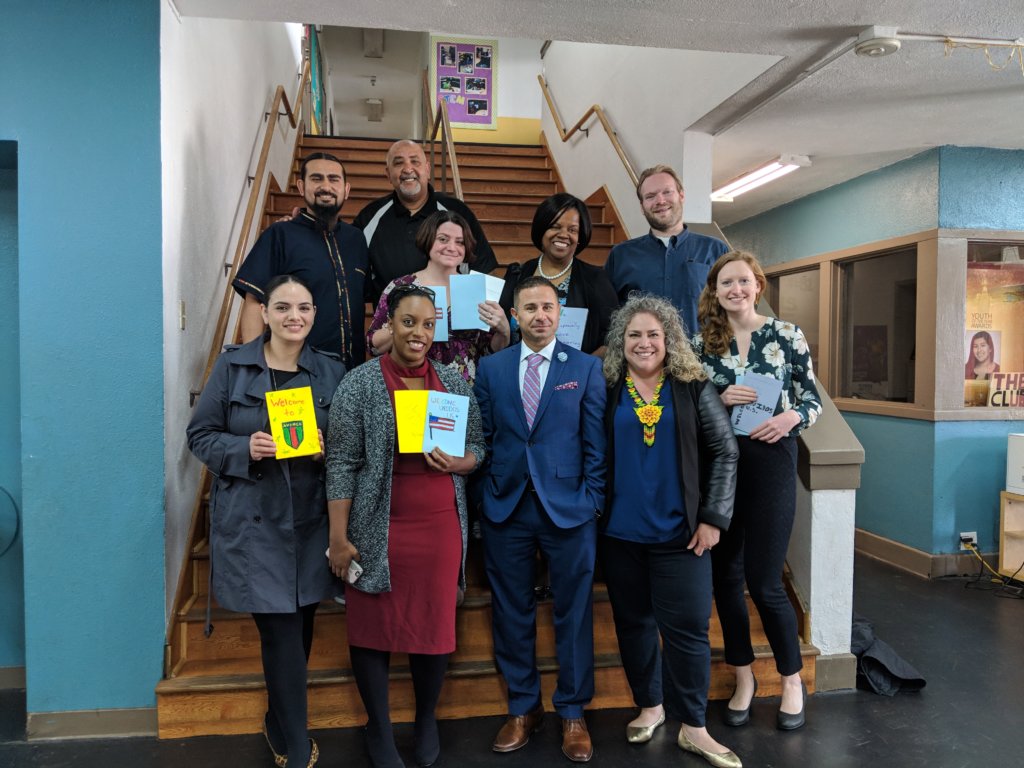A Story Narrative of a Child Farmworker: College Access for Hispanic Students

By: Sergio Jara Arroyos, a 2019-2020 National Institute of Latino School Leaders Fellow and the Director of Alumni Strategy and Engagement for Teach For America Los Angeles.
Growing up as a child of migrant farmworkers in Washington state’s Yakima Valley, you learn quickly that your place is in the field, not at the front of the class. At least, that is the unspoken narrative that has been passed down by generations. This attitude is one of the reasons the children of migrant farmworkers have the highest dropout rate of any group in the country. According to the National Farm Worker Ministry, 45 to 60 % of these children drop out of school. Only 10% of them finish high school.
I resolved to be among the few migrant farmworker kids who succeed in school, but I found obstacles at every step. I hope that by sharing my story I can help others growing up in similar situations see that college is a real possibility, but there are things that everyone from politicians to educators to the students themselves need to do to clear the path.
Keep up with the latest from UnidosUS
Sign up for the weekly UnidosUS Action Network newsletter delivered every Thursday.
Behind from the Start
The red ink on my homework made it clear I was behind from the start. I felt like a failure by the fourth grade. I used to sit at the kitchen table sobbing because I did not fully understand the English instructions for my assignments. I questioned myself, thinking, ‘I am dumb. Everyone else in my class knows how to do this, yet I don’t.’
My low academic confidence made me believe I needed to keep a low profile. I tried to listen and not speak in class. I was terrified of saying the wrong thing and embarrassing myself. I tried to disappear.
But walling myself off didn’t feel right either. It wasn’t me.
Both my parents are farmworkers or campesinos. Like many children of campesinos, I began working alongside my parents in the fields by the age of 10. They instilled in me the sense of community, and a responsibility to provide for our family. My father had a third-grade education and my mother a sixth-grade education, both from rural Mexico. Their education was limited, but their expectation for mine was not.
“We want you and your sisters to be able to speak both English and Spanish. We want you to get your diploma, and we want you to not be mistreated on the job like we were,” they would often tell me. “We came to this country so that one day our kids could have a better life than ours.”
My parents trusted America’s public schools would provide us with opportunity and access. They only spoke Spanish, had a limited understanding of the education system, and worked long hours, making it hard for them to engage or see the need to engage the system the way more established or affluent parents might do.
This background is a part of me. I always felt welcome in the orchards where my parents worked. At school I was timid, speaking as little as possible in class never sharing about my home life. The orchard allowed me to blossom into an extrovert. In fact, my mother called me el locutor (radio announcer) and my father called me el abogado (lawyer) because I talked incessantly. It was among the trees that my voice was the loudest, even if it was silenced by the distance from my other world. Still, for a long time I resented being there.

Being in school was a break from working in the fields and the orchards, so I loved going there even when I couldn’t understand the English-language instruction. Because of my language barrier, I was tracked into English as a Second Language (ESL) program. This meant that all my intellectual and academic abilities were measured according to achievement tests in a language I was still learning. As a result, teachers were very likely underestimating me as a so-called “low-achiever.”
This ESL tracking also came with a sense of separation or even segregation from other students, because our classrooms were in portable trailers disconnected from the school building where the rest of the classes were held.
I felt seen
Our program’s resources were limited. The middle school library did not have an extensive section of books in Spanish. But I did find The Circuit: Stories from the Life of a Migrant Child by Francisco Jiménez, and it changed my own expectations as a learner. I read his book in awe. I knew how to pronounce the name of the characters (some of which were names of my aunts and uncles), I understood the poverty he talked about, the language barriers, and fear of immigration. As I read, I felt seen.
I looked up Francisco Jiménez and learned he was a college graduate and a professor. He too had been a migrant child who never thought that kids from the fields could make it to college. Jiménez’s autobiographical novel made it clear that when our public education system was created, it didn’t intend to serve people of color. While significant progress has been made with civil legislation stemming from 1954’s Brown vs. Board of Education, there are so many structures that perpetuate an opportunity gap for kids like me. This realization made it clear that I needed to leave the fields, because nobody should have to hide who they are. It was time to let my voice be elevated beyond the clutter of the trees.
College was the expected next step for the kids in Advance Placement (AP) courses. ESL was about graduating and landing a job. At that point, my greatest hope was to attend community college, and get a job at the local gas station or as a receptionist at a nice hotel.
But there was one counselor, Mrs. Hinnant, who pushed me to think differently, to think about enrolling for those AP classes. I didn’t know much about them, but she seemed to believe I had what it took. I took her up on it and was shocked to find that I was one of five Latinos in a class of 28 students. I quickly noticed that all my white peers knew each other, even though this was the first time I’d seen any of them. It was obvious that these AP courses were the norm for them. Some were taking as many as four at a time.
An asset, not a deficit
In a school campus of about 3,500 students, it had always seemed that the only way students like me were accounted for was through that remedial tracking system, but Mrs. Hinnant made sure to follow my progress in this new, more competitive arena. In fact, she was relentless. During a visit to her office on a lunch period, I jokingly said I wanted to apply to be the student body representative to the School Board. I laughed. She did not.
“You need to apply for this role. The School Board needs to hear and understand how difficult it is to be a Latino student in this school district,” she said sternly. “Do not think about your grades. Do not get in your head. You easily represent the experience of 75% of the student population throughout Pasco. You being a child farmworker is an asset, not a deficit.”
She printed out the application, excused me from my classes for the rest of the day and said, “You are not leaving until you are done.” As I sat in our school’s computer lab it was clear why I wanted to apply. What I failed to understand was this marked my many attempts along the way to navigate the structural oppression that had been part of my community for decades.
Pasco, Washington, like many towns in America was and is highly segregated. In the Time Magazine article Only Part of the Story Is Being Told About the Police Shooting in Pasco, Kate Brown, professor of history at University of Maryland Baltimore County (UMBC) and author of several award-winning books, notes:
- In 1944, Mexican Americans settled in Pasco after being hired in 1944 to help build the Hanford plutonium plant 60 miles away. They were not allowed to live on site in the large construction camp, nor in nearby Richland, so they moved into dorms, shacks, and trailers in what was known as the Pasco ghetto.
- For decades after World War II, East Pasco, a scatter of shacks and trailers by the rail yards with no garbage collection, water or sewer lines, remained essentially the only neighborhood open to Latinos and Blacks.
West or East of Road 68
Growing up in my town meant understanding the difference between living West or East of Road 68. This clear marker embraced structural segregation. Most of my White classmates in my AP courses lived West of Road 68. I lived in East Pasco.
Two weeks after submitting my application for the School Board seat, I stepped into Mrs. Hinnant’s office. With a sense of joy and confusion I shared with her that I got an interview. I remember saying out loud, “Do you think they made a mistake? I think they are going to call me later this week to fix their mistake.”
Once more, Mrs. Hinnant was unamused.
My family drove a small rundown car. This car had made countless trips to the fields. Yet when the time came for my interview, I pulled up to the school district office in this same car. As I sat there, it felt as if two worlds were colliding. I stepped out of the car and took a deep breath before I dared to open the building door.
An hour had never felt so short. All I recall at this point is my closing remark to the School Board:
“I know my grades are not the best. Part of me feels ashamed. Yet, my grades tell an untold story. I have been a student in your district for the last 11 years. My family has left multiple times. I have re-enrolled every single time. Each time I came back, I kept trying.
“In the sixth grade my family lost everything. Our building was set on fire, we lost our belongings. We slept in a rundown motel room. Yet the day after the fire, we still showed up to school. It meant shelter, it meant we got to eat, there was a sense of safety. We never said anything to our teachers. We simply showed up to learn.
“My story, like many other students in this district, is composed of showing up. At times not knowing how to best navigate this system or how to ask for help. Sometimes it feels safer to be silent.”
That day, I embraced being unapologetic about my lived experience. I became the first low-income Latino Representative to the School Board.
This was part of the growth I experienced that put me on a path to college. I gradually learned about my options through AOL dial-up, pamphlets, and college fairs. In my AP courses, my White peers would talk about the college visits they had done over the summer. For me, that option was not feasible, given that summer months were prime for the harvest.

I applied and got accepted to Whitworth University in 2013. In 2019, Whitworth was ranked the No. 3 regional university in the West by U.S. News & World Report. It was ranked No. 4 for best value, and No. 10 among the most innovative schools. In 2020, The Princeton Review rated Whitworth University as one of the Best Universities in the West for 2020.
The reason I applied to Whitworth was not its prestige, its awards, or academic rigor. I applied because in their application process, they had the option to omit your SAT scores. This option gave me the chance to explain why I belonged in higher education. Instead of sending scores that would not accurately represent my potential as a learner, I got to do an interview. I still remember opening the mailbox and seeing the large envelope. I got accepted.
Through my application process, I kept thinking to myself, “Do you even think you will get in? They will look at your grades and they will doubt.” This acceptance letter showed that I, like many students of migrant farm workers, have it within me to succeed. The odds are stacked against us. We must navigate a racialized and biased education system. But it’s possible to find authors who have lived experiences like ours to inspire us, to cultivate relationships with educators who can guide us to the information and resources we need and seek out institutions that are making a public effort to be more inclusive.
I did not want to be labeled as “the bad student from the bad part of town.” White structures presented barriers, and made me feel alienated and, at times, ashamed. Getting into college was hard, and the alienation continued all the way through to graduation.

But we can change that scenario for other Latino students. And since there’s an increase higher education enrollment among Latinos, it is imperative that both Hispanic Serving Institutions and non-Hispanic Serving Institutions provide support to Latino students. That population includes many children of migrant farmworkers like me, and, so today as a fellow with the UnidosUS National Institute of Latino School leaders, I’m advocating for them by pushing for the following:
- Increase funding set-aside in Title V by 3.5%, currently at $124,415,000.
- Require Hispanic Serving Institutions and non-Hispanic Serving Institutions to track and report support services provided to Latino students.
- Considering the growth in Hispanics attending higher education, institutions should be incentivized to increase enrollment and completion rates.
As a Latino leader in education, I am reminded that representation matters at all levels. First, it is essential that we share our stories with one another to feel less isolated in our education system. Second, we must share our stories to navigate obstacles in a racially biased system. Lastly, we must advocate to elected officials to enact policies and provide additional funding to remove barriers for low-income and English Language learners, many of whom are Latino students. We have a long way to go, but I am confident that we will get there.




